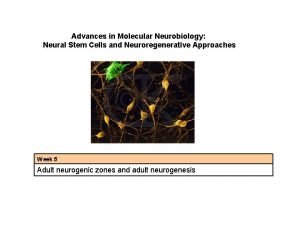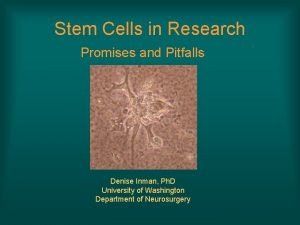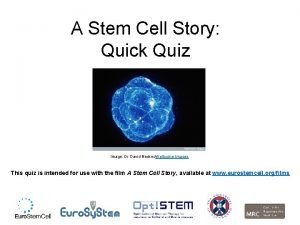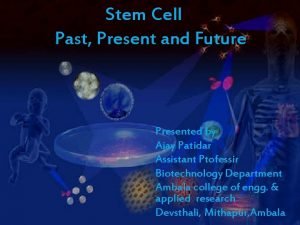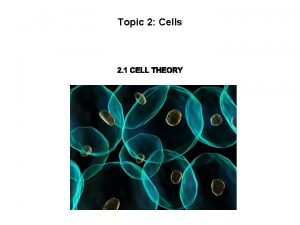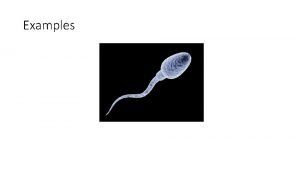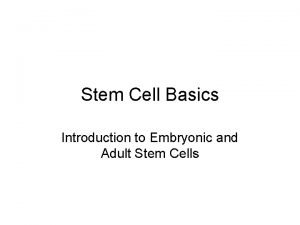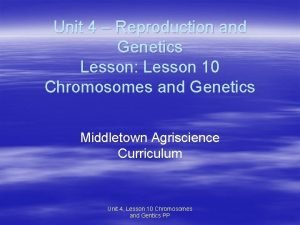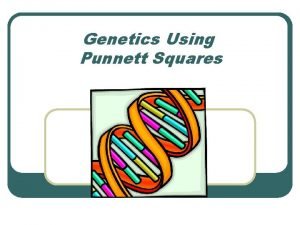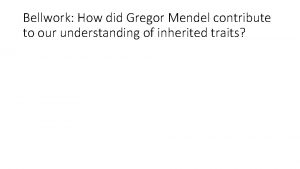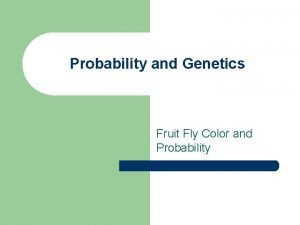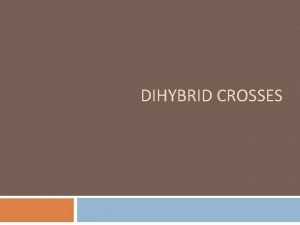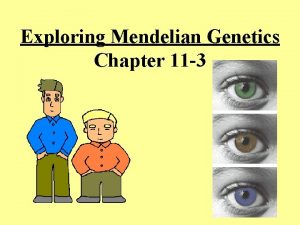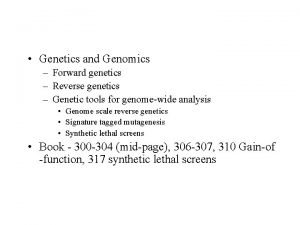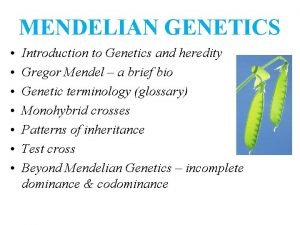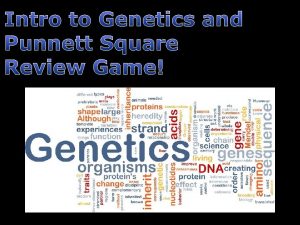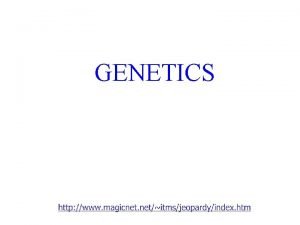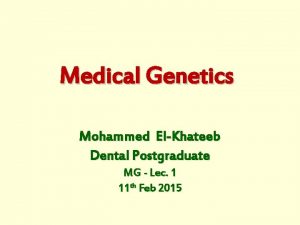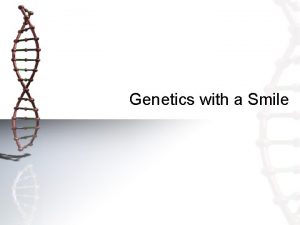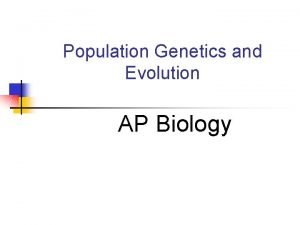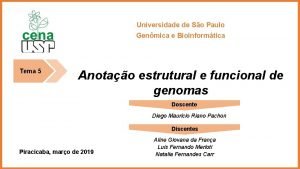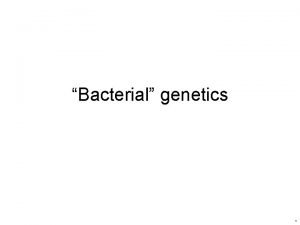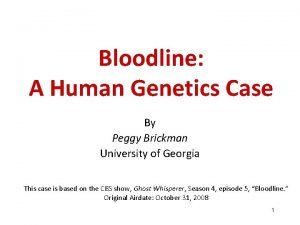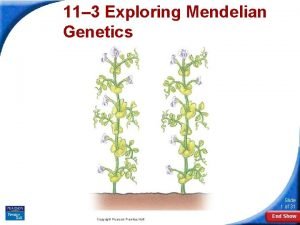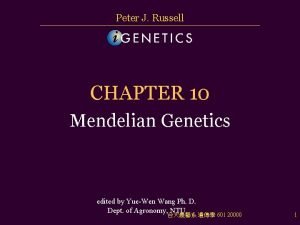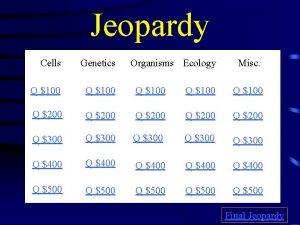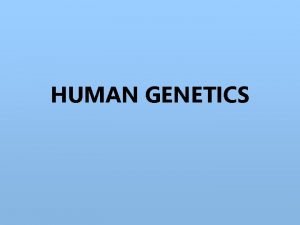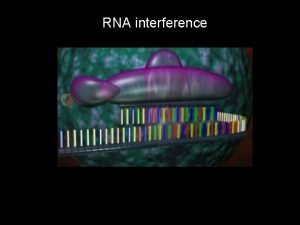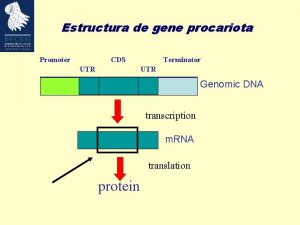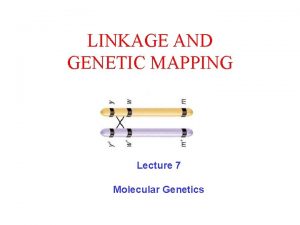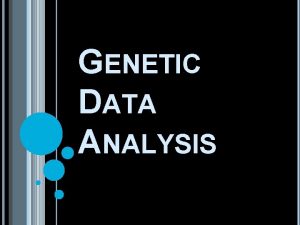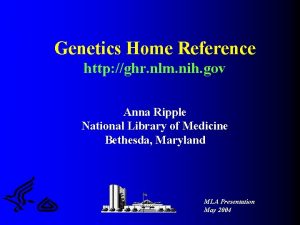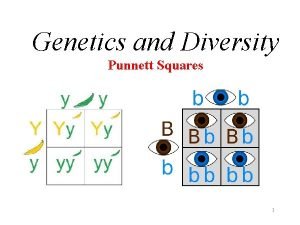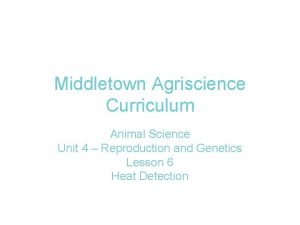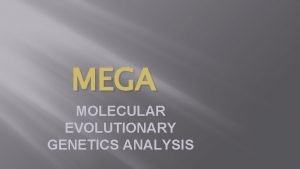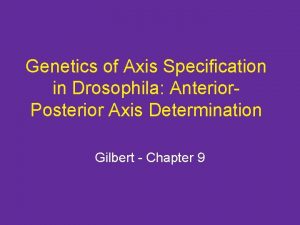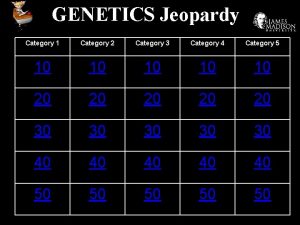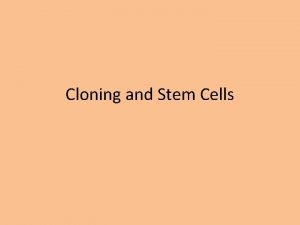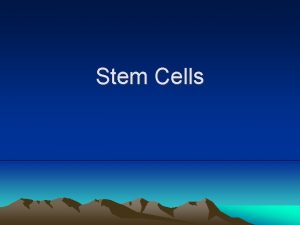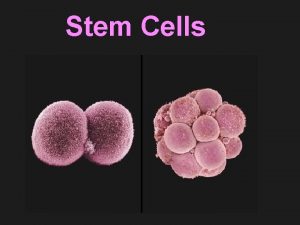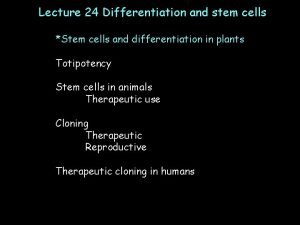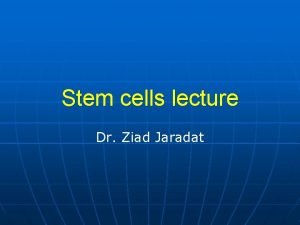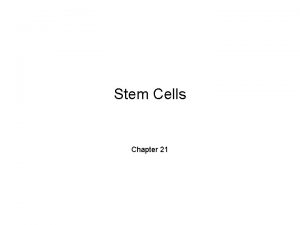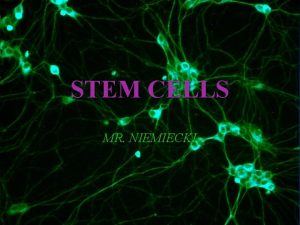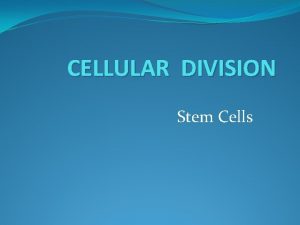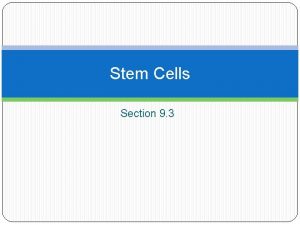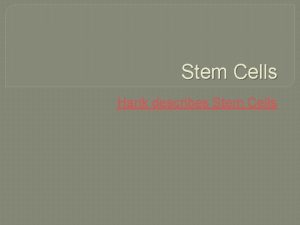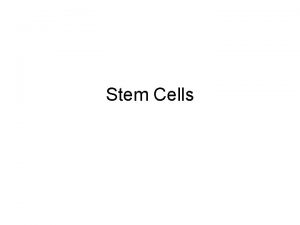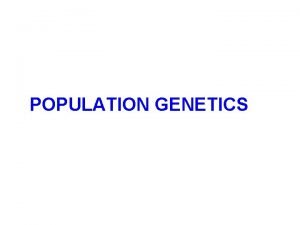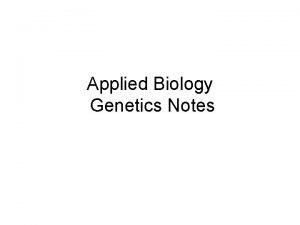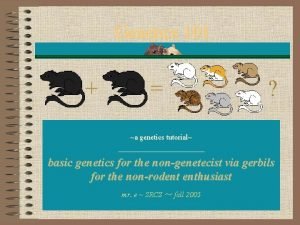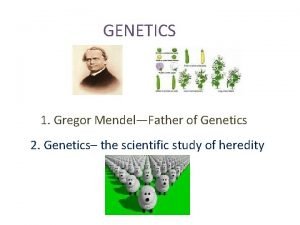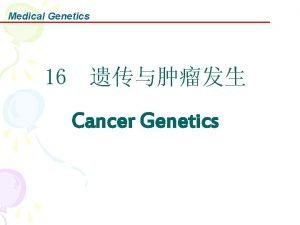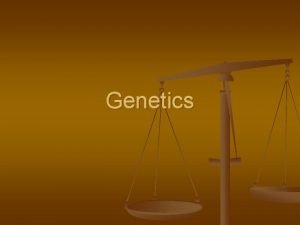Genetics What are stem cells Where are stem













































































- Slides: 77

Genetics

-What are stem cells? -Where are stem cells found? -Why are they valuable? -Should you save your stem cells? -Should you donate your stem cells? -Should you sell your stem cells? -Should we sell our blood and organs?

https: //www. youtube. com/watc h? v=0 g. F 8 b. CE 4 wq. A The Immortal Life of Henrietta Lacks – He. La cells

1) Should Henrietta’s family be compensated? 2) If you have ever had tissues collected, your cells are in a lab somewhere – likely being used for research. Should you be compensated? 3) Is it ethical to use cells taken from someone for research? How do you feel?

What is DNA made of? https: //www. youtube. com/watch? v=_POd. Wsii 7 AI

DNA makes up genes, genes make up chromosomes, chromosomes are in the nucleus of a cell

What is X? What is Z?

Genes – A section of DNA that deterrmines characteristics or traits. DNA – a set of instructions that determine what proteins will be made. Chromosomes – supercoiled DNA stored in nucleus. Body cells have 23 pairs. Heredity – passage of genes to offspring over generations

https: //www. youtube. com/watch? v=mn. Skz 8 s-b 44 https: //www. youtube. com/watch? v=Zf 2 hn. Fhy. JFI

All cells in an organism have identical DNA but each type of cell uses a different part of that DNA to do different jobs. That is how cells can look different and have very different functions.

The Law of Dominance Gregor Mendel - the father of genetics - noted that certain traits come in two forms: tall or short plants, green or yellow seeds. He also noted that some plants “bred true” – 2 short plants always made a short plant.

Dominant: the inherited characteristic that appears in an organism – overshadows the recessive. Recessive: the inherited characteristic masked by the dominant one. Only displayed when two recessive traits are present.

Dominant Cleft chin (dimple) Cheek dimples Free ear lobes Face freckles Hitchhikers thumb (bends backwards) Widows peak (forms a V on forehead) Roll tongue into a U Dark eyes Dark hair Curly or wavy hair Big lips 6 fingers on one or both hands Immune to poison ivy Pigmented skin Right Handed Dwarfism (below 4 feet tall) Recessive No cleft chin (no dimple) No dimples Attached ear lobes No freckles Straight thumb Straight hair line Cant roll tongue Light eyes Light hair Straight hair Thin lips 5 fingers Allergic to poison ivy Albino (very light and pink eyes) Left handed Normal height

THE Law of Dominance When an organism is hybrid for a pair of contrasting traits, only the dominant trait can be seen in the hybrid!

The Gene-Chromosome Theory Mendel’s traits were actually genes located on chromosomes. Offspring receive one chromosome in a pair from each parent. The dominant genes in each pair of chromosomes will show up in the offspring.

Think about eye color…Brown is dominant = B while blue is recessive = b BB = homozygous dominant = brown eyes Bb = heterozygous or hybrid = brown eyes bb = homozygous recessive = blue eyes *Dominant is not always more common!

Build a Baby! Find a partner, each of you flip a coin to draw your baby Trait 2 Heads - dominant 1 Head 1 Tail -hybrid 2 Tails - recessive Shape of face Round Square Cleft in chin Present Absent Skin Color Dark Medium Light Hair color Dark Light brown Blonde or Red Hair texture Curly Wavy Straight Widows peak Present Absent Eye color Brown Green or Hazel Blue Eye spacing Close together Normal Far apart Eye shape Almond Round Eye position Straight Slant up at corners Eye size Big Medium Small Eyelashes Long Short Eyebrows Bushy Fine

Trait 2 Heads – dominant 1 head 1 tail - hybrid 2 tails - recessive Eyebrows Space between Unibrow Nose size Big Medium Small Ears Big Medium Small Mouth Big Medium Small Lips Thick Normal Thin Freckles Present Absent Cheek dimples Present Absent Why would your actual baby look nothing like this?

Gene Expression Environmental factors (pollution, temperature, ect. ) can turn genes on or off.

The Himalayan Rabbit Fur color (white or black) is temperature dependant.



https: //www. youtube. com/watch? v=_wjf. YPEzi. YM

Oncogenes Genes that cause some kinds of cancer. When switched on, they lead to uncontolled cell growth = tumor. Present in most human cells.

Gene Linkage Many genes are present on each chromosome, therefore all genes on the same chromosome are said to be linked – they are inherited together. Red hair and freckles are linked…

Crossing Over When homologs join together during meiosis, the “legs” of the tetrad can switch places. This is an important source of variation!

Crossing-over

As you know, sexual reproduction leads to variation. Variation is due to crossing over and recombination during meiosis. Variation can also be thanks to MUTATION!

Mutation A sudden change in the structure or amount of genetic material. Can be harmful, beneficial, or have no effect on the organism. Mutations are only passed to offspring if they occur in a sex cell. https: //www. youtube. com/watch? v=Gie. Z 3 pk 9 YVo https: //www. youtube. com/watch? v=NYNX 2 FUZIos

Karyotyping – a way to see mutations The preparation of a photograph showing paired homologous chromosomes. Shows extra or missing chromosomes.

Down Syndrome – an entire extra chromosome

1. Nondisjunction Tetrads do not break apart during meiosis I. Causes the addition or loss of entire chromosomes. Causes many disorders.

Inversion = occurs when a piece of chromosome is rotated and reverses gene order. Inversions usually do not cause anything unusual. There is some evidence it leads to an increased risk for miscarriage for about 30% of affected couples.


Addition = occurs when a piece of a chromosome breaks off and attaches to another chromosome. The chromosome then has some genes repeated. Generally no effect but leads to fertility problems.


Deletion = occurs when a piece of a chromosome breaks off and some genes are lost. Small deletions are less likely to be fatal; large deletions are usually fatal - there always variations based on which genes are lost. Some medium-sized deletions lead to recognizable human disorders. Deletions are responsible for an array of genetic disorders, including some cases of male infertility and two thirds of cases of muscular dystrophy. Deletion results in a syndrome called Cri du chat, French for "cry of the cat" syndrome. It is found in approximately 1 in 50, 000 live births. The surviving infants have a distinctive cry, severe mental disability, and shortened life span.

https: //www. youtube. com/watch? v=La 1 D 4 c. NQ 5 k. Q


Translocation = the transfer of a part of a chromosome to a nonhomologous chromosome. Most translocation carriers are healthy and do not have any symptoms. About 6% of them have a range of symptoms which may include autism, intellectual disability, or congenital anomalies, leukemia, learning disabilities, & infertility.


Causes of Mutations Although mutations occur spontaneously, their incidence may be increased by different agents such as. . .

Radiation: x-rays, ultraviolet and radioactive substances. Chemicals: formaldehyde, benzene, and PCB’s (fertilizers & pesticides)

How does DNA replicate during cell division? The bonds between bases break & DNA molecule unzips. Free bases of A T C G floating in the nucleus attach to the unzipped DNA to make an exact copy. A goes with T C goes with G

How do genes control the production of protein? DNA is found in the nucleus while protein making ribosomes are found in cytoplasm. DNA must send ribosomes a message to make protein!

Protein Synthesis DNA strand in nucleus after unzipping: Transcription in nucleus onto m. RNA codons: Translation at the ribosome onto t. RNA anticodons: Amino Acids assembled at ribosome: The amino acids fold to make a specific protein! ATG CCC GAC TAA CCG


https: //www. youtube. com/watch? v=0 Elo-z. X 1 k 8 M

https: //www. youtube. com/watch? v=h 5 m. Jb. P 23 Buo

Genetics of sex Women & men are very different, but just a few genes create that difference In mammals = 2 sex chromosomes X & Y 2 X chromosomes = female: XX X X X & Y chromosome = male: XY https: //www. youtube. com/watch? v=k. MWxu. F 9 YW 38 X Y

The sex of the offspring is determined by the male parent because the male has both the X and the Y chromosome. Female parents can only contribute X chromosomes.

Sex-linked pedigree

King Edward 8 th

Sex Linked Traits A trait that is controlled by a gene found on the sex chromosomes. The chance of showing that trait depends on the sex of the individual.

Genetic Disorders Over 150 known disorders Caused by gene or chromosome mutations Most are recessive and result in abnormal proteins that don’t function

Detecting Genetic Disorders Genetic disorders can be detected either before or after birth. Sometimes carriers of defective genes can be identified.

Amniocentesis A long needle is inserted into the amniotic sac of a th pregnant woman in the 16 week of pregnancy. Some fluid is removed and it contains cells of the fetus.

Amniocentesis

DNA Fingerprinting using Gel Electrophoresis Done in state lab – Biodiversity / Botana Curus Used to determine paternity, evolutionary relationships, solve crimes, etc. Restriction enzymes cut DNA into fragments. Fragments are inserted into a gel and an electric current is run through it. Fragments spread out and create a unique pattern for everyone!



DNA Evidence in the O. J. Simpson Trial


Methods of Genetic Engineering Biologists can now cut, separate, and splice together DNA sequences in any order. Allows them to engineer a set of genetic changes into an organisms DNA. https: //www. youtube. com/watch? v=BK 12 d. Qq 4 s. Jw

Recombinant DNA fragments of one organism can actually be combined with fragments of another organism to obtain desirable traits.

100 pounds of pig pancreas to get 1 pound of insulin!

Recombinant DNA – Ecoli and human!

Applying Genetic Engineering Medicine: Insert human gene for interferon into bacteria to make a protein that helps us fight viruses. Gene Therapy: Replacing defective genes.

Farming: Insert genes into plants to make them resistant to disease. Using growth hormones on farm animals. Human Genome Project: Decoded all of the genes of human heredity. Has provided clues to genetic disorders.

GMO’s Genetically Modified Organism A gene from one organism is inserted into the nucleus of another, possibly unrelated organism to obtain a desirable trait Not a chemical added to or sprayed onto something – not a pesticide to kill pests or an herbicide to kill weeds https: //www. youtube. com/watch? v=s. H 4 bi 60 al. ZU

CRISPR – a gene editing tool… it can fix faulty genes in individual cells!!! https: //www. youtube. com/watch? v=ZIm. Vkl 8 QTW 8 https: //www. youtube. com/watch? v=0 Mkie 4 R 7 ha. A https: //www. youtube. com/watch? v=9 vi. B 4 p. PT 1 E 0


The End!

Mutate your DNA strand Mutate one Thymine to an Adenine. What happens? What kind of mutation is this? What are the effects of this mutation?

Mutate your DNA strand Choose one set of paired nucleotides in your DNA strand Make an identical copy of that rung of your DNA ladder and attach it directly underneath the original strand. What kind of mutation is this? What effect could this kind of mutation have?

Mutate your DNA strand Cut off the first nucleotide pair of your DNA strand. What kind of mutation is this? What effect could this mutation have?

Mutate your DNA strand Trade the DNA rung that you cut off with another group and attach that piece to the bottom of your DNA strand. What kind of mutation is this? What effect could this mutation have?
 Antigentest åre
Antigentest åre Prokaryotic cells
Prokaryotic cells Prokaryotic vs eukaryotic transcription worksheet
Prokaryotic vs eukaryotic transcription worksheet Masses of cells form and steal nutrients from healthy cells
Masses of cells form and steal nutrients from healthy cells Haploid and diploid venn diagram
Haploid and diploid venn diagram Cells cells they're made of organelles meme
Cells cells they're made of organelles meme Animal rights and animal welfare venn diagram
Animal rights and animal welfare venn diagram Paranasal sinus development
Paranasal sinus development Label
Label Why dna is more stable than rna?
Why dna is more stable than rna? Prokaryotic cell
Prokaryotic cell Loop of henle
Loop of henle Prokaryotic cells vs eukaryotic cells
Prokaryotic cells vs eukaryotic cells Red blood cells and white blood cells difference
Red blood cells and white blood cells difference Organelle trail
Organelle trail Parafollicular
Parafollicular Chapter 8 cellular reproduction cells from cells
Chapter 8 cellular reproduction cells from cells Stem cells webquest
Stem cells webquest Stem cells
Stem cells Classification of stem cells
Classification of stem cells Stem cells specialization
Stem cells specialization Conclusion of stem cells
Conclusion of stem cells Which statement best describes embryonic stem cells?
Which statement best describes embryonic stem cells? Where can scientists obtain stem cells? *
Where can scientists obtain stem cells? * Cellpast
Cellpast Outline one therapeutic use of stem cells
Outline one therapeutic use of stem cells Pluripotent stem cells examples
Pluripotent stem cells examples Precursor cells
Precursor cells Genetics middletown
Genetics middletown Chapter 12 molecular genetics
Chapter 12 molecular genetics Genetics
Genetics How did gregor mendel contribute to genetics
How did gregor mendel contribute to genetics Probability in genetics
Probability in genetics Heredity concept map
Heredity concept map Foil method biology
Foil method biology Excelsior college basic genetics
Excelsior college basic genetics Mendelian genetics
Mendelian genetics Section 11-3 exploring mendelian genetics
Section 11-3 exploring mendelian genetics C5oh name
C5oh name Reverse genetics definition
Reverse genetics definition Codominance
Codominance Punnett square word problems
Punnett square word problems Genetics jeopardy
Genetics jeopardy Human genetics concepts and applications 10th edition
Human genetics concepts and applications 10th edition Bottleneck effect
Bottleneck effect Genetics with a smile
Genetics with a smile Vulcan fingers genetics
Vulcan fingers genetics Genetics
Genetics Nature review genetics
Nature review genetics Nature review genetics
Nature review genetics Mendel monk
Mendel monk Bloodline a human genetics case answer key
Bloodline a human genetics case answer key Section 11-3 exploring mendelian genetics
Section 11-3 exploring mendelian genetics Is o blood type recessive
Is o blood type recessive Branch diagram dihybrid cross
Branch diagram dihybrid cross Ecology jeopardy
Ecology jeopardy Nature review genetics
Nature review genetics Nature genetics
Nature genetics Blood type alleles
Blood type alleles Who is the father of genetics?
Who is the father of genetics? Chapter 7 extending mendelian genetics
Chapter 7 extending mendelian genetics Forward genetics
Forward genetics Genetics
Genetics Cds genetics
Cds genetics Nature genetics
Nature genetics Recombination frequency
Recombination frequency Probability image
Probability image Http://ghr.nlm.nih.gov/
Http://ghr.nlm.nih.gov/ Tongue rolling genetics
Tongue rolling genetics Holandric genes
Holandric genes Blue eyed mom brown eyed dad
Blue eyed mom brown eyed dad Molecular genetics
Molecular genetics Section 11-5 linkage and gene maps answer key
Section 11-5 linkage and gene maps answer key Dominant and recessive genes
Dominant and recessive genes Genetics middletown
Genetics middletown Mega molecular evolutionary genetics analysis
Mega molecular evolutionary genetics analysis Axis specification in drosophila
Axis specification in drosophila Genetics jeopardy
Genetics jeopardy


















